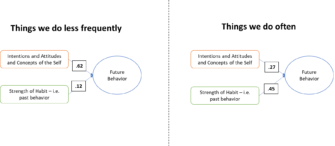Past Behavior Predicts Future Behavior – Who Cares?
This post’s title largely summarizes my view. Past giving predicts future giving and so begins the circular logic of donor understanding. It’s akin to noting that someone is on time because they tend to be punctual.
Knowing that past behavior predicts future behavior can make you more efficient but you can efficient your way out of business.
What we need in this sector is more effectiveness. And, if effectiveness is the goal it serves zero purpose to include past behavior in cause and effect modeling. Cause and effect modeling is different than the 99.9% of charity sector modeling aimed at prediction.
But, I was wro… I was wron…I was wrong. My old view gave short shrift to the formation of that past behavior that leads it to become a predictor of future behavior. It’s called a habit and habit formation – good and bad – is at the root of successful fundraising. But unfortunately, we have far more ‘bad’ habit giving in our sector than good.
How so? The non-giving is, in our world, bad habit. And it’s rampant. The “oft-asked, never givers”, “the give once not againers”, the “first 3 month quitters” in monthly giving…
In actuality, our desire to embed good habits often requires undoing the bad ones, especially in direct mail fundraising in the US and F2F outside the US. The direct mail pond is small and grossly overfished. The same people get mailed over and over and over. Those who give are the extreme minority. Those who don’t have formed a habit.
That same description applies to the F2F channel in places like Canada, the UK, most of mainland Europe, Australia.
The frequency with which we do the desired behavior matters a lot to understanding it. Highly frequent behaviors like drinking coffee or brushing your teeth are on the right of the graphic below. Voting and donating are done far less frequently (by comparison) and seen on the left. What makes these causal models different is the importance of the subconscious, automated, requires-no-thought, just-do-it habit. The numbers are not percentages, they show importance.

(Note: there are some interactions in these models that we’ve left out for simplicity sake)
Our intention to give at all, or specifically to a group matters a lot, as does one’s attitudes about giving generally and specifically. And, last but not least, deciding if giving will reinforce a part of who you are– your Identity. Habit matters very little. This isn’t to say that some people don’t make giving a habit, some do but they are the exception, not the rule.
On the flip side, non-giving is habitual for many. It’s auto-pilot. Their sorting and immediately discarding solicitations in the digital or physical waste bin is a big predictor of future behavior. In our world, especially direct mail in the US and canvassing outside the US, we have to simultaneously consider how to break that bad habit in our effort to influence intentions, attitudes and self-concepts to trigger the good behavior.
(Note: don’t think digital is some nirvana of good habits waiting to be formed with nary a bad habit existing. That ecosystem is arguably the worst of the bunch with incredibly well-ingrained, “bad” habits and a ton of bad actors – bots, disinformation – that undermine efficacy and efficiency of all things digital)
In other words, the same potential/prospect/fundraising target lives in both models. Doing more of the same will only guarantee a deeper entrenchment of their bad habit. The ways to break the bad habit are very different from what we should do to get folks to give.
Habit is closely tied to context and stable environmental cues. How to break the stable context of the prospect avoiding your canvasser or not answering the door or chucking your digital/mail solicitation?
Here are a but a few ideas:
- Change the format. If it always looks the same it’ll get the same result. This applies to canvassing to, hence the idea of VR or other higher production ideas (e.g. sets in the mall).
- Introduce a new wrinkle. Door solicitors get higher conversion rates but fewer contacts when leaving a do0r-hanger the day prior to a canvass alerting people to the activity. What’s your email or mail equivalent?
- Copy that says something very different from your standard “urgent” gram or other well-worn, likely pressuring call-out that is a sure fire path to circular bin.
- Timing. Having something arrive at a less common time period – i.e. August instead of December. Or middle of the month instead of beginning when all the bills show.
Kevin


